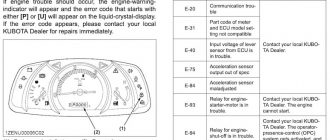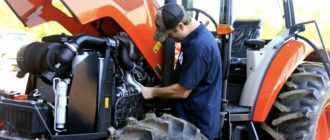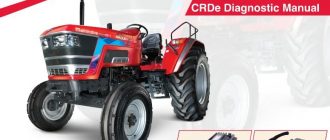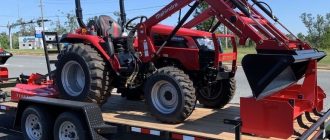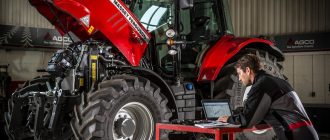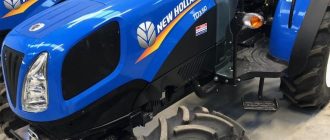- New Holland Tractor Error Codes
- Error Codes from 1003 to 2080
- Error Codes from 2081 to 3078
- Error Codes from 3079 to 4127
- Error Codes from 4128 to 8007
- Error Codes from 8008 to 15024
- How to Read New Holland Fault Codes?
- How To Clear New Holland Error Codes
- FAQ for New Holland Fault Codes
- New Holland Tractor Troubleshooting Chart
Tractor fault codes, also known as diagnostic trouble codes (DTCs), are alphanumeric codes used by modern tractors equipped with onboard diagnostic (OBD) systems to indicate issues with various systems and components. These codes are generated when the New Holland tractor’s electronic control unit (ECU) detects a problem during system checks or operation. Tractor fault codes usually consist of several numbers, sometimes with letters at the beginning of the code.
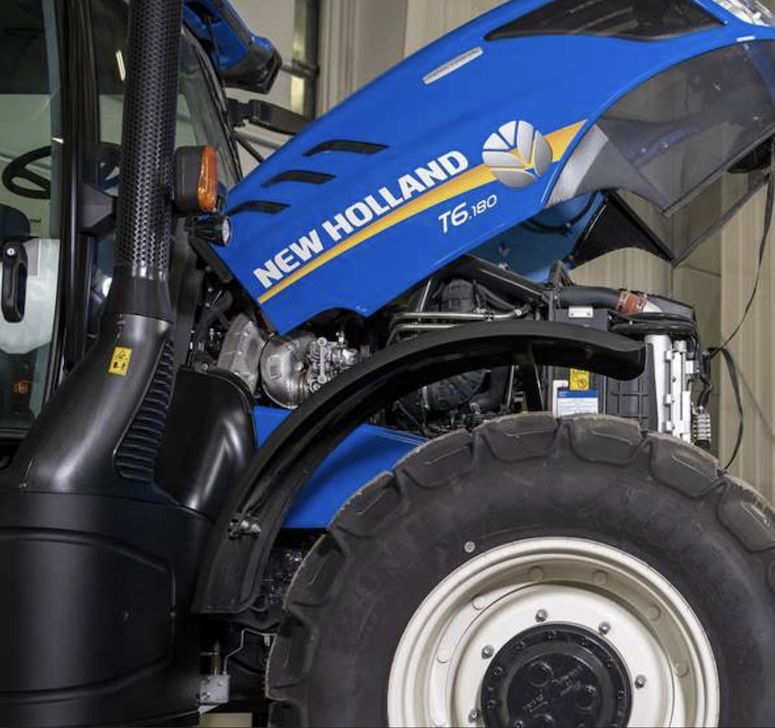
Each specific fault code corresponds to a particular problem or malfunction detected by the New Holland tractor’s sensors and diagnostic algorithms. For example, a 2067 code might indicate a “Forward Solenoid Circuit Malfunction”, while a 7032 code could suggest a “Steering angle sensor out of minimum range”. When a New Holland fault code is triggered, it is stored in the tractor’s memory, and in many cases, it will also illuminate a warning light on the instrument panel to alert the operator of the issue. To diagnose and repair the problem, technicians can use diagnostic scan tools to retrieve fault codes, interpret their meanings, and perform troubleshooting procedures as needed.
New Holland Tractor Error Codes
New Holland tractor error codes vary depending on the specific model and the type of onboard diagnostic system installed. These codes typically indicate issues with various tractor systems, including engine, transmission, hydraulic system, and electronic components. Without specific model information, here are some common New Holland tractor fault codes (main controller):
Error Codes from 1003 to 2080
| Error Number | Error Description |
|---|---|
| 1003 | Speed Sensor Error |
| 1004 | Speed sensor signal too high |
| 1005 | Speed sensor signal too high |
| 1006 | Slip control potentiometer signal too low |
| 1007 | Slip control potentiometer signal too high |
| 1008 | Tractor Lift/Run Switch Malfunction |
| 1009 | Both external switches tripped at the same time |
| 1010 | Height limit potentiometer too low |
| 1011 | Height limit potentiometer signal too high |
| 1012 | Fall rate potentiometer signal too low |
| 1013 | Fall rate potentiometer signal too high |
| 1014 | R/H load cell signal too weak |
| 1015 | R/H load cell signal too high |
| 1016 | L/H load cell signal too weak |
| 1017 | L/H load cell signal too high |
| 1018 | Both load cells disconnected |
| 1019 | Load cell voltage too low |
| 1020 | Load cell voltage too high |
| 1021 | Position/Thrust Control Potentiometer Too Low |
| 1022 | Position/Thrust Control Potentiometer Too High |
| 1023 | Tractor Control panel disabled |
| 1024 | Perform Hydraulic Lift Auto Calibration |
| 1025 | Mouse lift lever potentiometer signal too low |
| 1026 | Mouse lift lever potentiometer signal too high |
| 1027 | Maximum Lift arm position potentiometer too low |
| 1028 | Maximum Lift arm position potentiometer too high |
| 1029 | Hydraulic Control Valve Disabled |
| 1030 | Ground signal open circuit (not used) |
| 1031 | Chassis wiring harness disconnected |
| 1032 | Traction load potentiometer shorted to +12V |
| 1033 | Traction Load Potentiometer Open Circuit |
| 1049 | Wheel speed sensor circuit open |
| 1053 | 5V link, shorted to +12V |
| 1054 | Reference voltage 5 V Short to ground. |
| 1057 | Module failure (not in use) |
| 1059 | 5 volt reference open circuit (not used) |
| 1063 | Lower Solenoid Circuit Open |
| 1064 | Lift Solenoid Circuit Open |
| 1065 | Lower Solenoid Shorted |
| 1066 | Short circuit of the lift solenoid |
| 1067 | EDC hydraulic valve flow too low |
| 1068 | Height limit Calibration error |
| 2001 | ‘N’ – Shuttle too fast error |
| 2002 | Flash N error |
| 2003 | ‘CP’ – Clutch Pedal Required |
| 2004 | ‘P’ – Handbrake Error |
| 2005 | Creeper selection error |
| 2011 | Clutch Pedal Potentiometer Signal Too Low |
| 2012 | Clutch Pedal Potentiometer Signal Too High |
| 2013 | Up and down buttons at the same time |
| 2014 | Switch 4/5 error (not used) |
| 2015 | HI/LO shift lever switches both closed |
| 2016 | Creeper Solenoid Short Circuit |
| 2021 | Tractor Chassis Harness Error |
| 2024 | Synchro clutch not calibrated |
| 2026 | Engine RPM Too High |
| 2027 | Engine RPM Too Low |
| 2035 | Reset Solenoid Circuit Malfunction |
| 2036 | Reset solenoid open circuit |
| 2037 | Clutch Switch Circuit Open |
| 2038 | Short circuit of the solenoid valve 4 clutch |
| 2039 | Clutch solenoid valve 4 open circuit |
| 2040 | Short circuit of the clutch solenoid 3 |
| 2041 | Clutch solenoid valve 3 open circuit |
| 2042 | Short circuit of the clutch solenoid 2 |
| 2043 | Clutch solenoid valve 2 open circuit |
| 2044 | Short circuit of the clutch solenoid 1 |
| 2045 | Clutch solenoid valve 1 open circuit |
| 2046 | Fuse 12 open circuit (not used) |
| 2047 | Clutch pedal switch set too high |
| 2048 | Clutch pedal switch set too low |
| 2049 | Tractor Wheel speed sensor shorted or open |
| 2051 | Oil temperature sensor open circuit |
| 2052 | Oil temperature sensor short circuit |
| 2053 | 5 V potentiometer supply voltage too high |
| 2054 | Potentiometer supply voltage too low 5 V |
| 2055 | No signal from wheel speed sensor |
| 2056 | Low range switch open |
| 2057 | High range switch open |
| 2058 | Seat switch shorted for 25 hours |
| 2059 | Lever Switch Disagree |
| 2060 | Synchro Fwd no longer in use |
| 2061 | F/R synchronizer potentiometer signal too high |
| 2062 | F/R synchronizer potentiometer signal too low |
| 2063 | Synchro not moving forward |
| 2064 | Synchro won’t shift into reverse |
| 2065 | Forward Solenoid Circuit Open |
| 2066 | Reverse solenoid circuit open |
| 2067 | Forward Solenoid Circuit Malfunction |
| 2068 | Reverse Solenoid Circuit Malfunction |
| 2069 | Synchro reverse no longer engages |
| 2070 | Voltage when lever too far forward |
| 2071 | Voltage too low with lever forward |
| 2072 | Voltage Too High When Reverse Lever Engaged |
| 2073 | Reverse lever voltage too low |
| 2075 | Flywheel speed sensor frequency too high |
| 2076 | Flywheel Speed Sensor Circuit Open |
| 2077 | Flywheel speed sensor short circuit |
| 2080 | Synchro 4 no longer in use |
Error Codes from 2081 to 3078
| Error Number | Error Description |
|---|---|
| 2081 | 4/5 Synchronizer potentiometer signal too high |
| 2082 | 4/5 Synchronizer potentiometer signal too low |
| 2083 | Synchro 4 power on error |
| 2084 | Synchro 5 power on error |
| 2085 | Synchro 4 Open circuit solenoid |
| 2086 | Synchro 5 Open circuit solenoid |
| 2087 | Synchro 4 solenoid short to 12V |
| 2088 | Synchro 5 solenoid short to 12V |
| 2089 | Synchro 5 no longer used |
| 2090 | Output speed too high in slider |
| 2091 | Solenoid C3 clutch not calibrated |
| 2092 | Solenoid C4 clutch not calibrated |
| 2093 | High Clutch not calibrated |
| 2094 | Low Clutch not calibrated |
| 2095 | Solenoid C1 clutch not calibrated |
| 2096 | Solenoid C2 clutch not calibrated |
| 2097 | Clutch 5 not calibrated |
| 2098 | Solenoid C5 shorted to 12V |
| 2099 | Solenoid C5 open circuit |
| 2100 | Dump solenoid C5 short circuit to 12V |
| 2101 | Open circuit reset solenoid C5 |
| 2124 | Flywheel torque sensor not calibrated |
| 2199 | Creeper option not included |
| 3001 | Accelerator Pedal Signal INVALID |
| 3002 | Accelerator Pedal Signal – SOURCE HIGH |
| 3003 | Accelerator Pedal Signal – SOURCE LOW |
| 3004 | Accelerator Pedal Signal – NO SIGNAL |
| 3005 | Accelerator Pedal Signal – ALL OTHER FAULTS |
| 3006 | Coolant Temperature Alarm – ABOVE NORMAL |
| 3007 | Coolant Temperature Signal – SOURCE HIGH |
| 3008 | Coolant Temperature Signal – SOURCE LOW |
| 3009 | Coolant Temperature Signal – NO SIGNAL |
| 3010 | Air temperature signal (boost) – SOURCE HIGH |
| 3011 | Air temperature signal (boost) – SOURCE LOW |
| 3012 | Air temperature signal (boost) – NO SIGNAL |
| 3014 | Fuel Temperature Alarm – ABOVE NORMAL |
| 3015 | Fuel Temperature Alarm – SOURCE HIGH |
| 3016 | Fuel Temperature Signal – SOURCE LOW |
| 3017 | Fuel Temperature Signal – NO SIGNAL |
| 3018 | Boost pressure signal – ABOVE NORMAL |
| 3019 | Boost Pressure Signal – SOURCE HIGH |
| 3020 | Boost Pressure Signal – SOURCE LOW |
| 3021 | Boost pressure signal – NO SIGNAL |
| 3022 | Boost pressure signal – ALL OTHER FAULTS |
| 3023 | Barometric pressure alarm – ABOVE NORMAL |
| 3024 | Barometric pressure signal SOURCE HIGH |
| 3025 | Barometric pressure signal – SOURCE LOW |
| 3026 | Barometric pressure alarm – NO SIGNAL |
| 3027 | Oil pressure signal – ABOVE NORMAL |
| 3028 | Oil pressure signal – BELOW NORMAL |
| 3029 | Oil pressure signal – SOURCE HIGH |
| 3030 | Oil Pressure Signal – SOURCE LOW |
| 3031 | Oil pressure signal – NO SIGNAL |
| 3032 | Oil pressure signal – ALL OTHER FAULTS |
| 3033 | Oil temperature alarm – ABOVE NORMAL |
| 3034 | Oil Temperature Alarm – SOURCE HIGH |
| 3035 | Oil Temperature Alarm – SOURCE LOW |
| 3036 | Oil temperature signal – NO SIGNAL |
| 3037 | Power Stage Fuel Filter Heater – SOURCE HIGH |
| 3038 | Power Stage Fuel Filter Heater – SOURCE LOW |
| 3039 | Power Stage Fuel Filter Heater – NO SIGNAL |
| 3040 | HS Power Stage Cold Start Heater Relay – SOURCE HIGH |
| 3041 | HS Power Stage Cold Start Heater Relay – SOURCE LOW |
| 3042 | HS Power Stage Cold Start Heater Relay – NO SIGNAL |
| 3043 | Adapt.cylinder balancing Cylinder 1 – SOURCE HIGH |
| 3044 | Adapt.cylinder balancing Cylinder 5 – SOURCE HIGH |
| 3045 | Adapt.cylinder balancing Cylinder 3 – SOURCE HIGH |
| 3046 | Adapt.cylinder balancing Cylinder 6 – SOURCE HIGH |
| 3047 | Adapt.cylinder balancing Cylinder 2 – SOURCE HIGH |
| 3048 | Adapt.cylinder balancing Cylinder 4 – SOURCE HIGH |
| 3049 | Tractor Battery voltage signal – ABOVE NORMAL |
| 3050 | Tractor Battery Voltage Signal – BELOW NORMAL |
| 3051 | Tractor Battery Voltage Signal – SOURCE HIGH |
| 3052 | Tractor Battery voltage signal – SOURCE LOW |
| 3053 | LS Power Stage Cold Start Lamp – SOURCE HIGH |
| 3054 | LS Power Stage Cold Start Lamp – SOURCE LOW |
| 3055 | LS Power Stage Cold Start Lamp – NO SIGNAL |
| 3056 | Cold Start Heater Monitoring – BELOW NORMAL |
| 3057 | Cold Start Heater Monitoring – FALSE |
| 3058 | Cold Start Heater Monitoring – SOURCE LOW |
| 3059 | Cold Start Heater Monitoring – NO SIGNAL |
| 3060 | Injector Solenoid Valve, Cylinder 1 – NOT AVAILABLE |
| 3061 | injector solenoid valve, cylinder 1 – HIGH SOURCE |
| 3062 | injector solenoid valve, cylinder 1 – SOURCE LOW |
| 3063 | injector solenoid valve, cylinder 1 – NO SIGNAL |
| 3064 | injector solenoid valve, cylinder 5 – NOT ALLOWED |
| 3065 | injector solenoid valve, cylinder 5 – HIGH SOURCE |
| 3066 | injector solenoid valve, cylinder 5 – SOURCE LOW |
| 3067 | injector solenoid valve, cylinder 5 – NO SIGNAL |
| 3068 | injector solenoid valve, cylinder 3 – NOT ALLOWED |
| 3069 | injector solenoid valve, cylinder 3 – HIGH SOURCE |
| 3070 | Injector Solenoid, Cylinder 3 – SOURCE LOW |
| 3071 | injector solenoid valve, cylinder 3 – NO SIGNAL |
| 3072 | injector solenoid valve, cylinder 6 – NOT AVAILABLE |
| 3073 | injector solenoid valve, cylinder 6 – HIGH SOURCE |
| 3074 | injector solenoid valve, cylinder 6 – SOURCE LOW |
| 3075 | injector solenoid valve, cylinder 6 – NO SIGNAL |
| 3076 | Injector Solenoid Valve, Cylinder 2 – NOT ACCEPTABLE |
| 3077 | injector solenoid valve, cylinder 2 – HIGH SOURCE |
| 3078 | injector solenoid valve, cylinder 2 – SOURCE LOW |
Error Codes from 3079 to 4127
| Error Number | Error Description |
|---|---|
| 3079 | injector solenoid valve, cylinder 2 – NO SIGNAL |
| 3080 | injector solenoid valve, cylinder 4 – NOT ALLOWED |
| 3081 | injector solenoid valve, cylinder 4 – HIGH SOURCE |
| 3082 | injector solenoid valve, cylinder 4 – SOURCE LOW |
| 3083 | injector solenoid valve, cylinder 4 – NO SIGNAL |
| 3084 | injector booster C1 voltage – SOURCE HIGH |
| 3085 | Injector Amplifier C1 Voltage – SOURCE LOW |
| 3086 | injector booster C2 voltage – SOURCE HIGH |
| 3087 | injector booster C2 voltage – SOURCE LOW |
| 3088 | Speed Up Signal – NOT AVAILABLE |
| 3089 | Speed up Signal – SOURCE LOW |
| 3090 | Segment Speed Signal – NOT AVAILABLE |
| 3091 | Segment Speed Signal – SOURCE LOW |
| 3092 | Engine speed sensor – IMPOSSIBLE |
| 3093 | Engine speed sensor – SOURCE HIGH |
| 3094 | Engine Speed Sensor – SOURCE LOW |
| 3095 | Engine Speed Sensor – NO SIGNAL |
| 3096 | Equipment CAN (A) – NO SIGNAL |
| 3097 | Equipment CAN (B) – NO SIGNAL |
| 3098 | CAN TSC1_TE Control – SOURCE LOW |
| 3099 | Control CAN TSC1_TE – NO SIGNAL – CAN TE & CAN AE error |
| 3100 | Control CAN TSC1_AE – SOURCE LOW |
| 3101 | CAN TSC1_AE Control – NO SIGNAL |
| 3102 | Fuel pressure control CP3 – ALL OTHER FAULTS |
| 3103 | Fuel pressure signal – ABOVE NORMAL |
| 3104 | Fuel pressure signal – SOURCE HIGH |
| 3105 | Fuel pressure signal – SOURCE LOW |
| 3106 | Fuel pressure signal – NO SIGNAL |
| 3107 | Fuel Pressure CC HS Power stage 1. Control – SOURCE HIGH |
| 3108 | Fuel Pressure CC HS Power stage 1. Control – SOURCE LOW |
| 3109 | Fuel Pressure CC HS Power stage 1. Control – NO SIGNAL |
| 3110 | Rail Pressure Relief Valve Control – ABOVE NORMAL |
| 3111 | Rail Pressure Relief Valve Control – BELOW |
| 3112 | Rail Pressure Min./Max. error – HIGH SOURCE |
| 3113 | Main Relay Defect – ABOVE NORMAL |
| 3114 | Main Relay Defect – BELOW NORMAL |
| 3115 | Main Relay Defect – INCREDIBLE |
| 3116 | Main relay defect – SOURCE HIGH |
| 3117 | ECU Self-Test Shutdown Ways (Startup) – IMPOSSIBLE |
| 3118 | Sensor Power Supply – NOT AVAILABLE |
| 3119 | Sensor power supply – NO SIGNAL |
| 3120 | Sensor Power Supply – ALL OTHER FAULTS |
| 3121 | PTO torque sensor open circuit |
| 3122 | Short circuit of the PTO engine torque sensor |
| 3123 | Tractor PTO Torque not CAL error |
| 3124 | hand throttle potentiometer, high error 2. |
| 3125 | Manual throttle potentiometer 2 Low error. |
| 3126 | hand throttle potentiometer high error 1. |
| 3127 | Manual Throttle Potentiometer 1 Low error. |
| 3128 | Manual Throttle Potentiometer Differential. error. |
| 3129 | Manual Throttle Idle Switch High Error |
| 3130 | Hand Throttle Low Idle Switch Error |
| 3131 | Ways to disable self-test ECU (startup) |
| 3132 | CRPM Switch short |
| 4001 | Aux-stick signal (AUX1) out of range low |
| 4002 | Auxiliary joystick signal (AUX1) out of range |
| 4003 | Signal from remote rate potentiometer 1 (AUX 1) |
| 4005 | Aux-stick signal (AUX2) out of range low |
| 4006 | Auxiliary joystick signal (AUX2) out of high range |
| 4007 | Signal from remote rate potentiometer 2 (AUX 2) |
| 4008 | Signal from Remote Valve 2 Timer Pot 1 Out of Range |
| 4009 | Aux-stick signal (AUX3) out of range low |
| 4010 | Auxiliary joystick signal (AUX3) out of range |
| 4011 | Signal from remote rate potentiometer 3 (AUX 3) is out of range. |
| 4015 | Signal from remote rate potentiometer 4 (AUX 4) is out of range. |
| 4016 | Remote valve signal Timer 1 potentiometer out of range. |
| 4040 | Tractor Supply Voltage Too Low |
| 4041 | Tractor Supply Voltage Too High |
| 4042 | Armrest module (ARU) CAN “Bus off” |
| 4043 | Controller failure (case check) |
| 4044 | Controller failure (flash) |
| 4045 | Controller failure (data memory) |
| 4100 | Remote No.1 Received no control message |
| 4101 | Remote No.1 Control Message invalid |
| 4102 | Remote No.1 EEPROM Error |
| 4103 | Remote No.1 switched to failover mode |
| 4104 | Remote Control No.1 Powered |
| 4105 | Remote Control No. 1 Surge Protection |
| 4106 | Remote No.1 Spool down |
| 4107 | Remote No.1 Spool up |
| 4108 | Remote No.1 Float position not reached |
| 4109 | Remote No.1 Manual control |
| 4110 | Remote No.1 Driver defective |
| 4111 | No.1 remote potentiometer defective. |
| 4112 | Remote No.1 Failed to set neutral |
| 4113 | Remote control spool No.1 not in neutral when key is turned on |
| 4114 | Remote No.2 No control message received |
| 4115 | Remote No.2 Control Message unreliable |
| 4116 | Remote No.2 EEPROM Error |
| 4117 | Remote No.2 switched to failover mode |
| 4118 | Remote No.2 Energized |
| 4119 | Remote Control No.2 Surge Protection |
| 4120 | Remote No.2 Spool movement too low |
| 4121 | Remote No.2 Spool up |
| 4122 | Remote No.2 Float position not reached |
| 4123 | Remote No.2 Manual control |
| 4124 | Remote No.2 Driver defective |
| 4125 | Remote No.2 potentiometer defective |
| 4126 | Console No.2 Failed to set neutral |
| 4127 | Remote control spool #2 not in neutral when key is turned on |
Error Codes from 4128 to 8007
| Error Number | Error Description |
|---|---|
| 4128 | Remote No.3 No control message received |
| 4129 | Remote No.3 control message implausible |
| 4130 | Remote No.3 EEPROM Error |
| 4131 | Remote No.3 Switched to Failsafe |
| 4132 | Remote Control No.3 Powered |
| 4133 | Remote Control No. 3 Surge Protection |
| 4134 | Remote No.3 Spool to Low |
| 4135 | Remote No.3 Spool up |
| 4136 | Remote No.3 Float position not reached |
| 4137 | Remote No.3 Manual control |
| 4138 | Remote No.3 Driver defective |
| 4139 | Remote potentiometer #3 defective. |
| 4140 | Remote No.3 Failed to set neutral |
| 4141 | Remote control spool No.3 not in neutral when key is turned on |
| 4142 | Remote No.4 No control message received |
| 4143 | Remote No.4 Control message implausible |
| 4144 | Remote No.4 EEPROM Error |
| 4145 | Remote No.4 Switched to Failsafe |
| 4146 | Remote Control No.4 Powered |
| 4147 | Remote Control No.4 Surge Protection |
| 4148 | Remote No.4 Spool down |
| 4149 | Remote No.4 Spool up |
| 4150 | Remote No.4 Float position not reached |
| 4151 | Remote No.4 Manual control |
| 4152 | Remote No.4 Driver defective |
| 4153 | Remote potentiometer #4 is defective. |
| 4154 | Remote No. 4 Failed to set neutral |
| 4155 | Remote No.4 Coil not in neutral when key is turned on |
| 4156 | Remote No.5 Spare |
| 4157 | Remote No.5 Spare |
| 4158 | Remote No.5 Spare |
| 4159 | Remote No.5 Spare |
| 4160 | Remote No.5 Spare |
| 4161 | Remote No.5 Spare |
| 4162 | Remote No.5 Spare |
| 4163 | Remote No.5 Spare |
| 4164 | Remote No.5 Spare |
| 4165 | Remote No.5 Spare |
| 4166 | Remote No.5 Spare |
| 4167 | Remote No.5 Spare |
| 4168 | Remote No.5 Spare |
| 4170 | EHR Control No.1 not calibrated |
| 4171 | EHR Control No.1 open circuit |
| 4172 | EHR Control No.1 Short circuit |
| 4173 | EHR Control No.2 not calibrated |
| 4174 | EHR Control No.2 open circuit |
| 4175 | EHR Control No.2 Short circuit |
| 4176 | Timer No.1 / No.2 not connected |
| 4177 | EHR Control No.3 not calibrated |
| 4178 | EHR Control No.3 open circuit |
| 4179 | EHR Control No.3 Short circuit |
| 4180 | EHR Control No.4 not calibrated |
| 4181 | EHR Control No.4 open circuit |
| 4182 | EHR Control No.4 Short circuit |
| 4183 | Timer No.3 / No.4 not connected |
| 4184 | EHR Joystick potentiometer X open circuit. |
| 4185 | Short circuit of the X potentiometer of the EHR joystick. |
| 4186 | EHR Joystick Y potentiometer open. |
| 4187 | Short circuit of the Y potentiometer of the EHR joystick. |
| 4190 | No messages from (EHR) #1. |
| 4191 | No messages from (EHR) #2. |
| 4192 | No messages from (EHR) #3. |
| 4193 | No messages from (EHR) #4. |
| 4194 | Engine Mode Switch #1 Defective |
| 4195 | Engine Mode Switch #2 Defective |
| 4196 | Engine Mode Switch #3 Defective |
| 4197 | Engine Mode Switch Malfunction #4 |
| 5001 | Rear PTO solenoid jammed |
| 5002 | Rear PTO solenoid stuck on |
| 5003 | Rear PTO brake circuit open |
| 5004 | Rear PTO brake overheating (not used) |
| 5005 | Tractor Brake switch, open circuit |
| 5007 | Rear PTO solenoid jammed |
| 5008 | Overcurrent in the rear PTO solenoid circuit |
| 5024 | Tractor Rear PTO not calibrated |
| 5027 | Rear PTO speed sensor circuit open (not implemented) |
| 5033 | Rear PTO in cab N/C switch open circuit |
| 5034 | Rear wing PTO switch open/short to ground. |
| 5035 | Rear Wing PTO Switch Input Short to +12V |
| 5036 | Tractor PTO won’t start |
| 5037 | Rear PTO switch in cab stuck closed |
| 5038 | PTO switches in cockpit and fender actuate in 2 seconds |
| 5039 | Incorrect voltage on wing power take-off switch |
| 5040 | Rear wing PTO switches reversed (not used) |
| 5041 | PTO disabled due to false load (not in use) |
| 5042 | PTO control switch short circuit |
| 5099 | Automatic PTO not engaged |
| 6020 | Tractor FWD New Switch Error |
| 6021 | FWD solenoid stuck on |
| 6022 | FWD solenoid stuck |
| 6023 | FWD Open circuit solenoid |
| 7014 | Differential lock switch error |
| 7015 | Differential lock solenoid stuck |
| 7016 | Differential Lock Solenoid Stuck On |
| 7017 | Open circuit differential lock solenoid |
| 7018 | Differential lock driver overheating |
| 7024 | Steering angle sensor not calibrated |
| 7031 | Steering Angle Sensor Out of Max Range |
| 7032 | Steering angle sensor out of minimum range |
| 8007 | Front PTO Solenoid Stuck On |
Error Codes from 8008 to 15024
| Error Number | Error Description |
|---|---|
| 8008 | Front PTO Solenoid Circuit Open |
| 8024 | Front PTO not calibrated |
| 8027 | Front PTO speed sensor circuit open |
| 8033 | Front PTO switch in cab, break contact, open circuit |
| 8036 | Tractor Front PTO won’t start |
| 8037 | Cab front PTO NO contact stuck closed |
| 8099 | Front PTO option not included |
| 9001 | Front HPL (High Pressure Lift) Potentiometer open circuit. |
| 9002 | Front HPL (High Pressure Lift) Short circuit of the potentiometer. |
| 10001 | Top Lock Solenoid Error |
| 10002 | Tractor Lift Solenoid Error |
| 10003 | Lower Solenoid Error |
| 10004 | Front axle potentiometer above threshold |
| 10005 | Front axle potentiometer below threshold |
| 10007 | Boost error, suspension cannot return to set value |
| 10008 | Downshift error, suspension cannot return to set value |
| 10009 | Lower Block Lock Solenoid Error |
| 10024 | Front suspension not calibrated |
| 10099 | Front suspension mode not included |
| 14001 | Rear PTO Speed Short to VCC or Open Circuit |
| 14002 | Rear PTO speed short to ground |
| 14011 | Engine speed sensor short to VCC or open circuit |
| 14012 | Engine speed sensor short to ground |
| 14015 | ADIC 5 volt reference too low – below 4 volts |
| 14016 | ADIC reference voltage too high 5 volts – above 6 volts |
| 14021 | Radar Speed Over Ground short to VCC or open circuit |
| 14022 | Radar Short Ground Speed |
| 14031 | Front PTO Speed Short to VCC or Open Circuit |
| 14032 | Front PTO speed short to ground |
| 14041 | Engine coolant temperature short to VCC or open circuit |
| 14042 | Engine coolant temperature short to ground |
| 14051 | Fuel level sensor short to VCC or open circuit |
| 14052 | Fuel Level Sensor Short to Ground |
| 14061 | Air brake pressure shorted to VCC or option set but sensor not connected |
| 14071 | Front hitch position shorted to 12 or 5 volts |
| 14072 | Front hitch position short to ground or open circuit |
| 14081 | Engine oil pressure short circuit to 12 or 5 volts |
| 14082 | Engine Oil Pressure Short to Ground or Open Circuit |
| 14091 | Output baud rate short to VCC or open circuit |
| 14092 | Transmission output speed short to ground |
| 14100 | Air brake pressure not set |
| 14101 | Fuel contamination sensor Not connected |
| 14900 | Missing (DA/DB/DE/DF) transmission module. |
| 14901 | Engine controller missing (EDC7) |
| 14902 | The (DD/DH) controller accessory (optional) module is missing. |
| 14903 | SCM controller (only GA 12×12) Missing. |
| 14904 | The armrest module (ARU) is missing. (only Steyr 16×16) |
| 14905 | Tractor KEYBOARD missing |
| 14906 | Quick Steering Controller (KA) is missing. |
| 14907 | DOG (Display Of Gears) is missing. |
| 15001 | Exceeding the safe operating wheel speed (10 km/h) with the system on or active. |
| 15002 | Steering wheel proximity sensor circuit open. |
| 15003 | Steering wheel proximity sensor short circuit. |
| 15006 | Split LVDT valve, open circuit. |
| 15007 | Short circuit of a split valve LVDT. |
| 15008 | Replace valve Solenoid open circuit. |
| 15009 | Replace Valve Solenoid Short Circuit Through. |
| 15010 | Emergency Switch Failure. |
| 15011 | The maximum switch-on time (5 minutes) has expired. |
| 15012 | Split valve spool stuck open. |
| 15013 | Replace valve or split valve spool stuck closed. |
| 15014 | A split valve spool stuck in the transition zone cannot determine which steering mode the tractor is exactly in. |
| 15015 | Cold oil, temperature below 5 degrees C. Instead, the fast steering light flashes, the error code is not active. |
| 15024 | System not calibrated. |
How to Read New Holland Fault Codes?
To read New Holland tractor fault codes, you typically need to follow these steps:
- Access Diagnostic Interface: Locate the diagnostic interface port on your New Holland tractor. This port is usually located near the instrument panel or under the hood.
- Connect Diagnostic Tool: Use a compatible diagnostic scan tool to connect to the diagnostic interface port. Ensure that the tractor’s ignition is turned on but the engine is not running.
- Retrieve Error Codes: Follow the instructions provided with your diagnostic tool to retrieve fault codes from the tractor’s electronic control unit (ECU). This may involve selecting the appropriate vehicle make (New Holland) and model, and then initiating a scan for fault codes.
- Interpret Error Codes: Once the scan is complete, the diagnostic tool will display any fault codes that are present. Write down or note these codes for further analysis.
- Consult Manual: Refer to your New Holland tractor’s service manual or consult with a qualified technician to interpret the meaning of the fault codes. The manual should provide a list of fault codes along with their descriptions and possible causes.
- Diagnose and Repair: Based on the fault code information, diagnose the underlying issue or malfunction affecting your New Holland tractor. This may involve performing additional tests, inspections, or component replacements as necessary.
- Clear Codes (Optional): After diagnosing and addressing the problem, you can use the diagnostic tool to clear the fault codes from the ECU’s memory. This step is optional but can be helpful for monitoring the effectiveness of repairs and ensuring that no lingering issues remain.
By following these steps, you can effectively read and interpret fault codes on your New Holland tractor, helping to diagnose and resolve any issues affecting its performance or operation.
How To Clear New Holland Error Codes
To clear New Holland error codes, follow these general steps:
- Identify the Error Code: Use a compatible diagnostic scan tool to retrieve the error codes stored in the tractor’s electronic control unit (ECU). Note down the specific error code(s) that you want to clear.
- Ensure the Issue is Resolved: Before clearing error codes, it’s crucial to address the underlying issue that triggered the codes. Troubleshoot and fix the problem related to the error code(s) to prevent them from reoccurring.
- Access Diagnostic Mode: Depending on the model of your New Holland tractor, access the diagnostic mode using the tractor’s onboard display or control panel. Refer to the tractor’s operator manual for instructions on accessing diagnostic mode.
- Clear Error Codes: Once in diagnostic mode, navigate to the option to clear error codes. Use the controls or touchscreen interface to select the option to clear error codes from the ECU’s memory.
- Confirm Clearing: Confirm the action to clear the error codes when prompted by the diagnostic system. Ensure that you want to proceed with clearing the codes, as this action cannot be undone.
- Exit Diagnostic Mode: After clearing the error codes, exit diagnostic mode on the tractor’s display or control panel. Return the tractor to its normal operating mode.
- Monitor Operation: Once the error codes are cleared, monitor the tractor’s operation to ensure that the issue has been resolved successfully. Pay attention to any warning lights or indicators that may reappear, indicating potential ongoing problems.
- Perform Test Operation: Consider performing a test operation or running diagnostic checks to verify that the tractor is functioning correctly and that the error codes do not reappear.
It’s essential to remember that clearing error codes without addressing the underlying issue may lead to recurring problems or issues with the tractor’s performance. If you’re unsure about troubleshooting or fixing the problem, consult with a qualified technician or New Holland dealership for assistance.
FAQ for New Holland Fault Codes
Here are some frequently asked questions (FAQ) about New Holland tractor fault codes:
Q1. What are New Holland tractor fault codes?
Answer: New Holland tractor fault codes are alphanumeric codes generated by the tractor’s electronic control unit (ECU) to indicate specific malfunctions or issues with the tractor’s various systems and components.
Q2. Where can I find New Holland tractor fault codes?
Answer: New Holland tractor fault codes can typically be retrieved using a compatible diagnostic scan tool connected to the tractor’s diagnostic interface port. The codes are stored in the ECU’s memory and can be accessed through the scan tool’s interface.
Q3. What do New Holland tractor fault codes mean?
Answer: Each New Holland tractor fault code corresponds to a specific issue or malfunction detected by the tractor’s onboard diagnostics system. These codes are designed to provide technicians with information about the nature and location of the problem, aiding in diagnosis and repair.
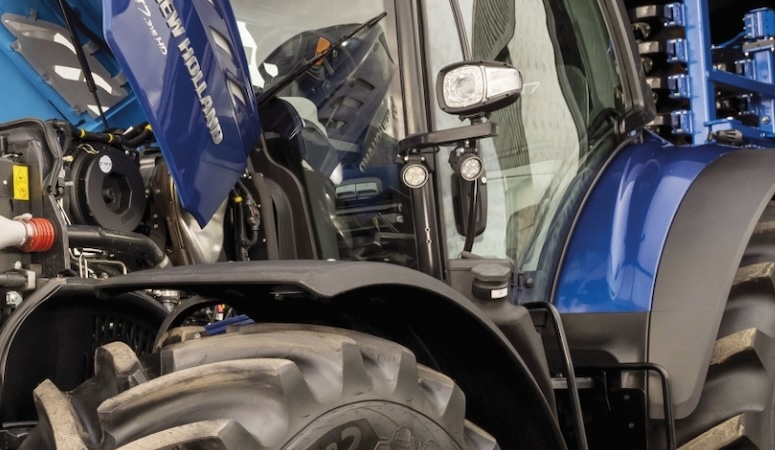
Q4. How do I interpret New Holland tractor fault codes?
Answer: Interpretation of New Holland tractor fault codes requires reference to the tractor’s service manual or consultation with a qualified technician. The manual typically contains a list of fault codes along with their descriptions, possible causes, and recommended repair procedures.
Q5. What should I do if I encounter a New Holland tractor fault code?
Answer: If you encounter a New Holland tractor fault code, the first step is to retrieve the code using a diagnostic scan tool. Once you have the code, refer to the service manual or seek assistance from a technician to interpret the code and diagnose the underlying issue. Follow the recommended repair procedures to address the problem effectively.
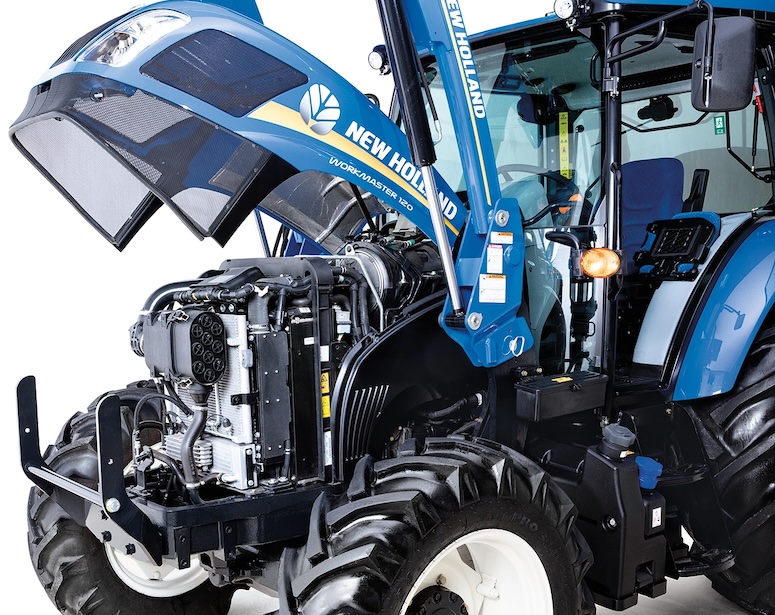
Q6. Can I clear New Holland tractor DTC codes?
Answer: Yes, many diagnostic scan tools allow you to clear fault codes from the ECU’s memory once the underlying issue has been addressed. However, it’s essential to ensure that the problem has been resolved before clearing the codes to prevent recurring issues.
Q7. Are New Holland tractor fault codes universal?
Answer: While many New Holland tractor fault codes may be similar across different models and years, it’s essential to consult the specific service manual or documentation for your tractor to ensure accurate interpretation and diagnosis.
New Holland Tractor Troubleshooting Chart
Here’s a New Holland tractor troubleshooting chart for various situations:
| Situation | Possible Causes | Troubleshooting Steps |
|---|---|---|
| Engine Will Not Crank | Dead battery, faulty starter, corroded connections | 1. Check battery charge and connections. 2. Test starter motor. 3. Inspect wiring for damage. |
| Engine Will Not Start | Fuel supply issues, ignition problems, air in fuel system | 1. Check fuel level and quality. 2. Inspect ignition system (spark plugs, ignition coil). 3. Bleed air from fuel system. |
| Engine Runs Rough Or Stalls | Dirty air/fuel filters, fuel quality issues | 1. Replace air and fuel filters. 2. Check fuel quality and tank for contaminants. 3. Inspect carburetor or fuel injection system for clogs or leaks. |
| Engine Knocks | Low oil level, worn bearings, poor fuel quality | 1. Check oil level and quality. 2. Inspect bearings and other internal engine components for wear. 3. Ensure proper fuel quality and octane rating. |
| Engine Overheats | Low coolant level, faulty thermostat, radiator issues | 1. Check coolant level and top up if necessary. 2. Test thermostat for proper operation. 3. Inspect radiator for damage or blockages. |
| Engine Lacks Power | Clogged air/fuel filters, low fuel pressure | 1. Replace air and fuel filters. 2. Test fuel pressure and replace fuel pump if necessary. 3. Check for intake or exhaust restrictions. |
| Low Oil Pressure | Low oil level, worn oil pump, oil viscosity too low | 1. Check oil level and top up if necessary. 2. Test oil pressure with a gauge. 3. Inspect oil pump and replace if worn or damaged. |
| Engine Uses Too Much Oil | Leaks, worn piston rings, poor maintenance | 1. Inspect engine for oil leaks and repair as needed. 2. Test compression to check for worn piston rings. 3. Follow recommended maintenance schedule for oil changes. |
| Engine Emits White Smoke | Coolant leak, cracked cylinder head, cold weather | 1. Check coolant level and inspect for leaks. 2. Test cylinder head for cracks or warping. 3. Allow engine to warm up properly in cold weather before operation. |
| Engine Emits Black Or Gray Smoke | Rich fuel mixture, clogged air filter | 1. Check air filter and replace if dirty or clogged. 2. Inspect fuel injectors for leaks or clogs. 3. Adjust carburetor or fuel injection system for proper fuel/air ratio. |
| High Fuel Consumption | Dirty fuel injectors, excessive idling | 1. Clean or replace fuel injectors. 2. Avoid excessive idling and maintain proper engine speed. 3. Check for fuel leaks and repair as needed. |
